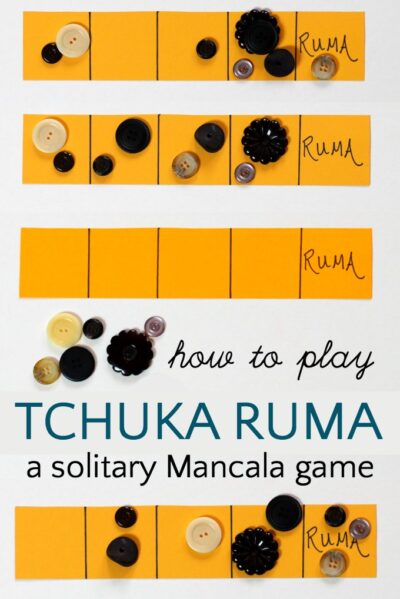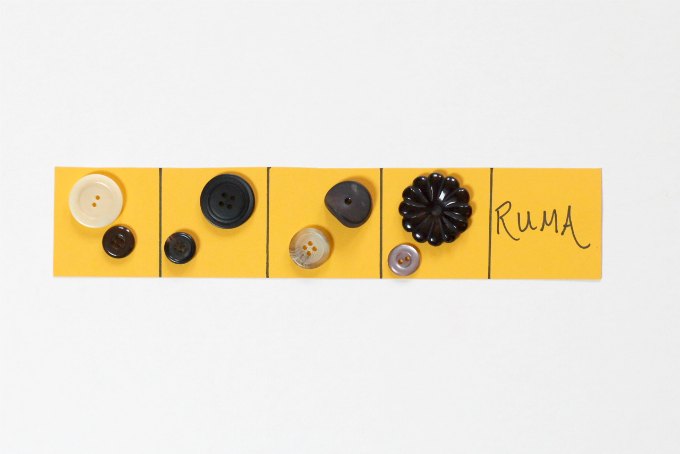Although I enjoy sharing our favorite board games via our game of the month feature, not every game we play is bought in a store. We have recently been having a great time playing Tchuka Ruma. Tchuka Ruma is an Indonesian transfer game that is a good precursor to the more sophisticated and well-known Mancala. Unlike Mancala, it is a solitary game and your kids can make it and play it in no time flat.

Simple, DIY games are very satisfying for kids and can often be played on the spur of the moment or on the go much more easily than board games. Ruma is a simple but surprisingly challenging game (more on that below!) My 10 year old played it on his own, but we also had a few face offs (see our video below). It keeps their brain active and they won't want to stop until they discover the solution.
What you need:
- Paper
- Pen
- Counters (we used buttons)
Make the board:
Divide a 10 inch strip of paper into 5 equal sections. We made 2 game boards. One is 10 x 2, the other is 10 x 3. Measurements don't need to be exact. Write "Ruma" in the final end section.
Objective: to get all the counters into the "Ruma" section.
Set up: place 2 counters in each of the empty sections.

How to play:
Pick up counters from any square and drop them, one by one into each section (similar to Mancala) towards the Ruma square. This is called "sowing the seeds".
What comes next depends on where your last counter falls.
If your last counter falls into Ruma then you move again, sowing seeds starting from the square of your choice.
If your last counter falls into an empty space, you lose.
If your last counter falls into a space already occupied by one or more counters, pick up all the counters from that square and continue sowing the seeds.
Good to know:
There is only one solution that will get all the counters into the Ruma square. There is a mathematical reason for this, but it is way above my head - ha ha ha. See the video if you want the solution. It was quite challenging for me, although I do not profess to be particularly adept at games like this!
It is fun, though, and my 10 year old and I did not want to give up. Even after we solved the game, it was not always easy to remember the exact steps, so even after your kids win, ask them to try and repeat the feat.
Watch a the new and improved (!) video of how to play. First I demonstrate how to lose (ha ha ha) but then you can watch a mother-son face off, plus at the very end I reveal the solution!
More DIY games we love:
- Tapatan, a 3 in a row game
- Dara: 3 in a row with a challenging twist!!
- Len Choa, a leopard and tiger hunt game
- Peg solitaire game
- Tower of Hanoi, logic puzzle



Maya says
It is a great game... Thank you for bringing back memory. I call it "congklak" in Javanese, one of the many regional languages in Indonesia.
How do you even find this game?
Have fun
Maya
Erica MomandKiddo says
We found it in a book!
Pattie Perry says
Thank you so much -- I made a board with the directions on the back so I could give it to my Sunday School students when they come in early. I have made several of your games for that purpose. They love challenges! I made a word document that has three gameboards on a page. I can email it to you.
Erica says
Oh, I love that idea of making printout like that and I'm so glad your students enjoyed the challenges!
Tanya Kelada says
Patty, would your be willing to share those game boards with another passionate Sunday school teacher?
My email is tjkelada@hotmail.com
Shiruvan says
I tried to resolve without watching your solution and I find an other way to win :
22220
20330
30041
01151
01061
12113
03113
03104
00215
00206
00017
00008
Erica says
Thanks for your enthusiasm and sharing your game play experience1
johnhenry says
This is a great puzzle! Thanks for sharing it. I have a couple of questions which the more mathematically minded students might like to approach.
For the 5-pit board (as described in your post), if you increase the number of seeds per pit, will there still be no solution, more than one solution, or still just one solution?
As you increase the size of the board, what is the solution state (none/more than one/just one) for each number of seeds put in the pits?
Make a matrix showing the solution move by move (just list the pit from which you start sowing for each move) for each size board and number of seeds, what patterns do you see in the matrix? You might have to make two matrices, one for size of board with the number of seeds increasing per column, and another showing a set number of seeds with the number of pits increasing. A mathematician could put these two factors together.
Erica says
Those are great explorations for kids interested in the mathematics aspect of the game! Thanks for sharing them.